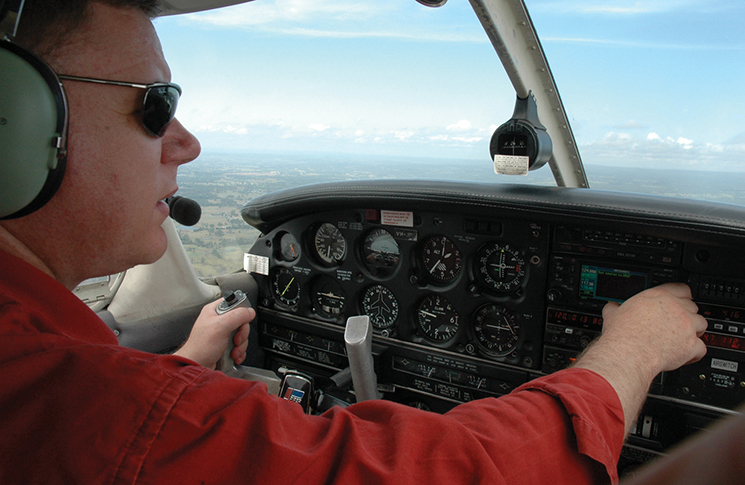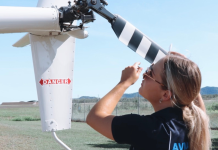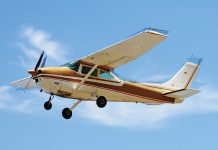- You must not continue an approach to land beyond the threshold until:
a. a preceding landing aircraft has rolled to a stop
b. an aircraft landing on a crossing runway has crossed or stopped short of the intersection
c. an aircraft taking off has started to roll
d. an aircraft taking off has reached 500 ft
2. An aircraft must be fitted with a radio when operating in Class G:
a. above 5,000 ft AMSL
b. above 3,000 ft AMSL
c. within 1,000 ft of cloud
d. more than 10 nm from an aerodrome
3. When operating at a non-controlled aerodrome, all circuit turns must be made:
a. to the left at all times
b. may be made to the right if a radio call is given
c. must be to the left unless stated otherwise in ERSA
d. to the left unless conducting training and a radio call is given
4. When operating within the vicinity of a non-controlled aerodrome, when are radio calls mandatory?
a. base leg
b. when it is reasonably necessary to avoid the risk of a collision with another aircraft
c. taxi, base, inbound, joining circuit
d. when you first contact the frequency
5. When departing a non-controlled aerodrome, an aircraft should not execute a turn opposite to the circuit direction until:
a. passing 2,000 ft AGL
b. 5 nm from the aerodrome
c. passing 500 ft AGL
d. well outside the circuit area and no traffic conflicts exist (normally 3 nm)
6. Before commencing a straight-in approach, the pilot must determine wind direction, runway in use and be established on final approach by:
a. 3 nm and give way to other traffic in the circuit pattern
b. 5 nm and give way to other traffic in the circuit pattern
c. 3 nm and give a radio call
d. 3 nm, give a radio call and give way to other traffic in the circuit pattern
7. When overtaking another aircraft, you must pass:
a. over it
b. under it
c. left of it
d. right of it
8. While an aircraft is being fuelled, no person shall conduct any activities that could potentially create a fire hazard within:
a. 15 m of the aircraft or equipment used to fuel the aircraft
b. 10 m of the aircraft or equipment used to fuel the aircraft
c. 25 m of the aircraft or equipment used to fuel the aircraft
d. 50 m of the aircraft or equipment used to fuel the aircraft
9. Except when taking off and landing, you must not fly an aircraft over a populous area or public gathering below:
a. 500 ft AGL
b. 1,000 ft AGL
c. 1,500 ft AGL
d. 2,000 ft AGL
10. If your radio fails in Class G airspace, you should remain outside controlled airspace, continue to broadcast and:
a. select 7600 on the transponder
b. select 7700 on the transponder
c. select 7700 on the transponder and descend below 5,000 ft as soon as practicable
d. select 7600 on the transponder and descend below 5,000 ft as soon as practicable
11. The standard format for a radio broadcast is:
a. location, aircraft type, callsign, position/intentions, location
b. location traffic, aircraft type, callsign, position/intentions, location
c. location traffic, callsign, aircraft type, position/intentions, location
d. location, callsign, aircraft type, position/intentions, location
12. An aircraft must not begin take-off until a preceding aircraft using the same runway has:
a. reached 1,000 ft AGL
b. reached 500 ft AGL
c. crossed the upwind end of the runway
d. become airborne
13. What calls are recommended in all circumstances when arriving or departing from a non-controlled aerodrome?
a. taxi, inbound, transiting through the vicinity
b. take-off, inbound, base, entering runway
c. taxi, inbound, joining circuit, transitioning through the vicinity
d. take-off, inbound, joining circuit
14. A white cross on a manoeuvring area means:
a. aerodrome unserviceable
b. gliding operations in progress
c. area marked by the cross is unfit for
use by aircraft
d. use only hard services
15. When transmitting an altitude over the radio, how should an altimeter reading of 2,500 ft be expressed?
a. twenty five hundred feet
b. two five zero zero feet
c. two and a half thousand feet
d. two thousand five hundred feet
To view the answers, go to the next page using the page navigation buttons below.





